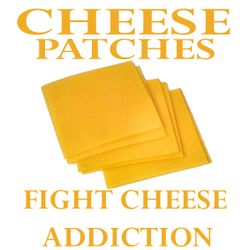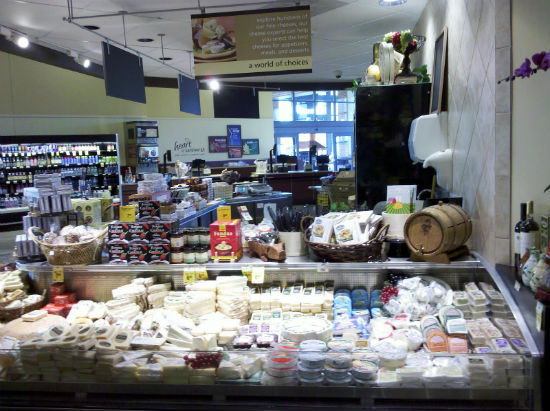I used to be one of those folks who thought he was being coy when he joked with others about how he was addicted to cheese. It was just so damn tasty that I couldn’t imagine enjoying food without it.
Now that I know much more about nutritional biochemistry I realize my snarky remarks had a hint of truth to them. Cheese really can have an addictive effect on people!
Casomorphins: Dairy’s Opiate
If the above picture makes your mouth salivate and a tingly feeling goes off in your brain, it’s important to understand the biological reason why this happens.
Casein is the name of a family of proteins commonly found in mammalian milk, especially in the milk of a cow. When your body digests casein it gets broken up into fragments, and inside the gut one of the peptide fragments that’s formed is beta-casomorphin-7.
And yes, I mean that morphine. Beta-casomorphin-7 is a naturally occurring opiate, which is a compound that creates euphoria and is the basis for drugs like morphine, codeine, and oxycodone. Cheese is essentially a lot of milk that’s been condensed and bacterially cultured to taste yummy. It takes about 10 lbs of milk to make 1 lb of cheese, and during the process most of the water is sucked out leaving a condensed mixture of casein peptides and fats. Fats create a euphoric effect unique to themselves, and the body also gets a shot of casomorphins which bind to opiate receptors in the brain, which make you feel happy and glowy, and that feeling of “my god, I love cheese so much!” propagates and grows a little bit stronger.
So yeah, you kind of can be addicted to cheese.
Woah! So Is Cheese Dangerous?
Like anything in toxicology, the discussion of health effects can only be truthfully considered when you account for dosage. And no, eating cheese does not have the same effect on the body as shooting up with heroin, so there’s no need to get carried away. But it is the same thing going on, just to a much lesser degree.
Casomorphins actually play a useful role in infant nutrition (the only time you’re actually meant to drink milk), which is why they’re there in the first place.
The long term health effects of a diet that’s high in casomorphins is not entirely clear, but there are some disturbing signs. The key is how much gets out of your gut and into your bloodstream, where the casomorphins can “swim upstream” into other parts of your body, bind with opiate receptors, and wreak havoc. Casomorphins that run amok have been linked to brain disorders in the central nervous system, formation of LDL cholesterol (the bad kind), sleep apnea, respiration disorders, and autism. And cheese addiction, of course.
It’s hard to quantify how much casomorphins are ingested because their presence is not specifically tested for, and the variability of the casomorphin content in food is very high. Small details in the manufacturing process, storage conditions, and your own genetics can all have large effects.
Why Would Mother Nature Put An Opiate In Your Food?
An interesting question is why an analogue of morphine would naturally occur in the first place. It’s actually quite fascinating.
Like I said before, all mammalian milk naturally contains casein, so all infants naturally ingest some casomorphine and benefit from its opioid-like effects.
So why would a baby need opium?
For one, opiods have a calming, euphoric effect. This calming effect can appease infants who are typically irritable and cranky. Think about how a baby quiets down after you give it milk. And think about how the baby learns to crave milk shortly after its born. Milk provides all sorts of vital nutrients to infants and casomorphins may be nature’s way of giving infants the hook they need to always desire it.
Casomorphins may also be the physiological reason behind the mother-infant bond itself. The brain and body are extremely developmentally sensitive in its early years, and the combination of physical contact, feeding, and casomorphins tells the baby “Hey! I really need this stuff and this is the only place to get it!”
Sources of Casomorphins in the Diet
Casein comes from milk. Milk does not naturally contain a lot of casomorphins, but various manufacturing and fermenting processes either increase the peptide concentration in dairy products or breakdown elongated proteins into casomorphin fragments. Cheese is by far the biggest culprit.
There’s no definitive way to measure how much beta-casomorphin-7 you’re getting in your diet, but a paper here studied BCM7 content in different types of cheeses. It found that that soft cheeses like brie had a higher casomorphin content than hard cheeses like gouda and cheddar.
Take it for what it’s worth.
The implications of this post are interesting to say the least, but it’s also important not to get carried away. Eating cheese isn’t really like taking codeine, BUT there’s a reason only suckling infants drink milk. Just sayin’.
Research, Stories, and References on Cheese Addiction, Beta-Casomorphin-7 and Its Health Effects:
Cass, H. et. al. “Absence of Urinary Opioid Peptides in Children With Autism” Arch. Dis. Child. August, 2008. pgs. 745-750
URL: http://www.autisme-gestion.fr/IMG/pdf/745.pdf
De Noni, I, et. al. “Review of the Potential Health Impact of Beta-Casomorphins and Related Peptides” European Food Safety Authority. January 2009.
URL: http://www.efsa.europa.eu/en/efsajournal/doc/231r.pdf
Taylor, Jenna. “Addiction to Cheese is Real Thanks To Casomorphins” Yum Universe. August 25, 2011
Sienkiewicz-Sz?apka, E, et. al. “Contents of Agonistic and Antagonistic Opioid Peptides In Different Cheese Varieties” International Dairy Journal. April 2009, pgs. 258-263.



This was a fascinating read and I am one of the afflicted. I love cheese. A few friends of mine have gone vegan but I can’t stand the thought because giving up dairy would be too tough for me.
LikeLike
Hi, I used to be just like you. and the funniest part is I craved cheesy things mostly during my pms(which started straight after ovulating for me). As soon as i became a vegan I had no more cravings or PMS!!! so all those hormones in Milk create PMS and the casomorphene makes you want cheese. It’s like a vicious cycle. You’ll see the benefits after you break away from it 🙂
LikeLike
Do you think I will need to put my grandkids in rehab to get them off cheese.
Now I know why it is such a comfort food to them and me!!!!
LikeLike
[…] neurological disorders.I’ve written before how the presence of casomorphins is actually the reason people feel like they’re “addicted to cheese.”For the purpose of our story, gluten basically acts the same way. Safe if it stays in the […]
LikeLike
I’m vegan and I had heard about cheese being a kind of morphine which is why so many are addicted. Thank you so much for this article. I will be sharing this with my vegetarian friends.
LikeLike
Juliana,
Thanks I’m glad you liked it 🙂
LikeLike
I’m sorry, but this is junk-science at best. There is ZERO reliable evidence that even SUGGESTS that cheese is in any way ‘addictive’ due to the presences of casomorphine.
Check this: “J Dairy Sci. 1994 Mar;77(3):672-5.
An assessment of the addiction potential of the opioid associated with milk.
Reid LD, Hubbell CL.
Source
Department of Psychology, Rensselaer Polytechnic Institute, Troy, NY 12180-3590.
Abstract
Eighty-four male rats were tested to determine their preference for one of two distinctive places in an experimental space. After an initial determination of place preference, rats were assigned to six groups. They were then subjected to procedures to condition a place preference using doses of beta-casomorphin, a standard dose of morphine, or placebo. Subsequently, rats were tested for place preferences. No evidence emerged indicating that injections of beta-casomorphin conditioned a place preference, but evidence indicated that morphine conditioned a place preference. Consequently, systemically administered beta-casomorphin has very limited or no reinforcing properties similar to those of morphine. Ingestion of milk products containing beta-casomorphin is not likely to become the focus of an addiction.” (http://www.ncbi.nlm.nih.gov/sites/entrez?Db=pubmed&Cmd=ShowDetailView&TermToSearch=8169274&ordinalpos=5&itool=EntrezSystem2.PEntrez.Pubmed.Pubmed_ResultsPanel.Pubmed_RVDocSum)
This is what comes from trusting your fellow bloggers, rather than actually doing the real work of investigating these claims in the peer-reviewed medical literature….
N_J
LikeLike
NJ,
I linked to another blog, but based the article off of source literature.
LikeLike
That study posetd by James Netizen appeared in the…wait for it…Journal of DAIRY Science…need I type any more?
LikeLike
And it ignores the fact that everything else I’ve written was based off of source literature…..I wasn’t making stuff up or borrowing from second rate sources.
LikeLike
been proven now though eh 🙂
LikeLike
🙂
I think cheese addiction is probably a downstream effect of leaky gut. If peptides are entering your bloodstream instead of amino acids then you could have big problems with cheese……and a lot of other things.
LikeLike
[…] […]
LikeLike
Casomorphins are derived from bovine casein that has A1 variant in its protein structure, when amino acid histidine replaced proline, which lead to a poor quality protein. The abovenentioned A1 variant is present in milk of later cow breeds such as Holstein. Milk from much earlier breads don’t have A1 variant in their casein. Neither do goat or sheep milk. I love my French cheeses that are made from milk free from casomorphines. And I enjoy my home-made kefir from goat milk. It’s totally safe. I believe that it would be nice to explane people such things, instead of creating casomorphine scare. You sound a little paranoid.
LikeLike
[…] dairy opiate called casomorphin and the subsequent suggestion that addiction to dairy is real. Jonathan Bechtel can give you a leg-up about it: “Beta-casomorphin-7 is a naturally occurring opiate, which is a […]
LikeLike